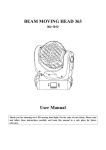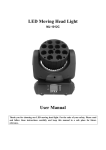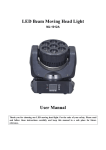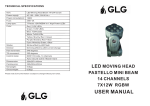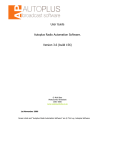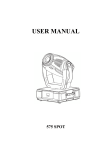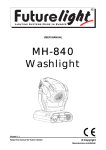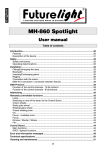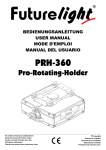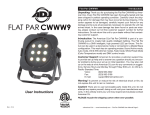Download Blizzard Blade RGBW User manual
Transcript
Blizzard Lighting, LLC www.blizzardlighting.com Waukesha, WI USA Copyright (c) 2012 TABLE OF CONTENTS Blade™ RGBW 1 1. Getting Started 3 What’s In The Box? Getting It Out Of The Box Powering Up! Getting A Hold Of Us Safety Instructions (Don’t Stick Your Hand In The Toaster!) 3 3 3 3 4 2. Meet The Blade™ RGBW 5 Features DMX Quick Reference The Blade™ RGBW Pin-up Picture 5 5 7 3. Setup 8 Fuse Replacement Connecting A Bunch Of Blade™ RGBW Fixtures Data/DMX Cables Cable Connectors 3-Pin??? 5-Pin??? Huh? Take It To The Next Level: Setting up DMX Control Fixture Linking (Master/Slave Mode) Mounting/Rigging 8 8 8 9 9 9 10 10 4. Operating Adjustments 11 Navigating The Control Panel Control Panel Menu Structure Address Mode - DMX Channel Selection Run Mode - DMX Mode, Auto and Sound Active Test Mode Setup Mode DMX Channel Values In-Depth Troubleshooting 5. Appendix A Quick DMX Lesson Keeping Your Blade™ RGBW As Good As New Returns (Gasp!) Shipping Issues Tech Specs Blade™ RGBW User Manual Rev. A Page 2 11 12 14 14 14 15 16 18 18 18 19 19 19 20 Copyright (c) 2012 Blizzard Lighting, LLC 1. GETTING STARTED What’s In The Box? • 1 x Blade™ RGBW Moving Head Fixture • An Ever-So-Handy Power Cord • A Sweet Mounting Bracket • This Lovely User Manual Getting It Out Of The Box Congratulations on purchasing one of the coolest, fastest LED fixtures anywhere! Now that you’re the proud owner of a Blade™ RGBW (or hopefully, BLADES!), you should carefully unpack the box and check the contents to ensure that all parts are present and in good condition. If anything looks as if it has been damaged in transit, notify the shipper immediately and keep the packing material for inspection. Again, please save the carton and all packing materials. If a fixture must be returned to the factory, it is important that the fixture be returned in the original factory box and packing. Powering Up! All fixtures must be powered directly off a switched circuit and cannot be run off a rheostat (variable resistor) or dimmer circuit, even if the rheostat or dimmer channel is used solely for a 0% to 100% switch. AC Voltage Switch - Not all fixtures have a voltage select switch, so please verify that the fixture you receive is suitable for your local power supply. See the label on the fixture or refer to the fixture’s specifications chart for more information. A fixture’s listed current rating is its average current draw under normal conditions. Check the fixture or device carefully to make sure that if a voltage selection switch exists that it is set to the correct line voltage you will use. Warning! Verify that the voltage select switch on your unit matches the line voltage applied. Damage to your fixture may result if the line voltage applied does not match the voltage indicated on the voltage selector switch. All fixtures must be connected to circuits with a suitable Ground (Earthing). Getting A Hold Of Us If something is wrong, just give us a call or send an email. We’ll be happy to help, honest. Blizzard Lighting W220 N1531 Jericho Ct. Ste E Waukesha, WI 53186 USA www.blizzardlighting.com 414-395-8365 Blade™ RGBW User Manual Rev. A Page 3 Copyright (c) 2012 Blizzard Lighting, LLC SAFETY INSTRUCTIONS • Please keep this User Guide for future use. If you sell the unit to someone else, be sure that they also receive this User Guide. • ALWAYS make sure that you are connecting to the proper voltage, and that the line voltage you are connecting to is not higher than that stated on the decal or rear panel of the fixture. • This product is intended for indoor use only. • To prevent risk of fire or shock, do not expose fixture to rain or moisture. • Make sure there are no flammable materials close to the unit while operating. • The unit must be installed in a location with adequate ventilation, at least 20in (50cm) from adjacent surfaces. Be sure that no ventilation slots are blocked. • ALWAYS disconnect from the power source before servicing or replacing fuse and be sure to replace with same fuse size and type. • ALWAYS secure fixture using a safety chain. NEVER carry the fixture by its cord. Use its carrying handles. • DO NOT operate at ambient temperatures higher than 104°F (40°C). • In the event of a serious operating problem, stop using the unit immediately. NEVER try to repair the unit by yourself. Repairs carried out by unskilled people can lead to damage or malfunction. Please contact the nearest authorized technical assistance center. Always use the same type spare parts. • NEVER connect the device to a dimmer pack. • Make sure the power cord is never crimped or damaged. • Never disconnect the power cord by pulling or tugging on the cord. • Avoid direct eye exposure to the light source while it is on. Caution! There are no user serviceable parts inside the unit. Do not open the housing or attempt any repairs yourself. In the unlikely event your unit may require service, please contact Blizzard Lighting at [email protected]. Blade™ RGBW User Manual Rev. A Page 4 Copyright (c) 2012 Blizzard Lighting, LLC 2. MEET THE Blade™ RGBW Moving Head MAIN FEATURES: • 36x 5-watt R/G/B/W CREE® LED’s • User selectable 11 or 15 DMX channels • Razor-sharp 1.1° beam angle + attachable 8° diffuser lens • Full color mixing in standalone, master/slave and DMX modes • Built-in automated programs via master/slave • Built-in sound activated programs via master/slave • User selectable 16-bit dimming • Defeatable pan/tilt correction with trim adjustment • Auto standby after DMX signal loss • Fixture ID addressing • 3-pin male input and 3-pin female output • PowerCon™ compatible AC power In/Out connectors • Compact, high quality housing Optical: • Beam Angle: 1.1° (8° with diffuser lens) • Light Source: 36x 5-watt R/G/B/W CREE® LED’s Control: • USITT DMX-512 (11/15 Channels) • 3-pin Input/Output • 4-button menu with LCD-TFT icon-based display DMX Quick Reference (11-Channel Mode) Channel What is does 1 Pan 2 Tilt 3 Pan Trim (16-bit) 4 Tilt Trim (16-bit) 5 Pan/Tilt Speed (Fast <--> Slow) 6 Red Intensity (0% <--> 100%) 7 Green Intensity (0% <--> 100%) 8 Blue Intensity (0% <--> 100%) 9 White Intensity (0% <--> 100%) 10 Dimmer (0% <--> 100%) 11 Custom Color (0% <--> 100%) Blade™ RGBW User Manual Rev. A Page 5 Copyright (c) 2012 Blizzard Lighting, LLC DMX Quick Reference (15-Channel Mode) Channel What is does 1 Pan 2 Tilt 3 X-Axis Trim (16-bit) 4 Y-Axis Trim (16-bit) 5 Pan/Tilt Speed (Fast <--> Slow) 6 Red Intensity (0% <--> 100%) 7 Green Intensity (0% <--> 100%) 8 Blue Intensity (0% <--> 100%) 9 White Intensity (0% <--> 100%) 10 Custom Color (0% <--> 100%) 11 Strobe (Slow <--> Fast) 12 Dimmer (0% <--> 100%) 13 Built-in Programs + Sound Active 14 Built-in Color Macros 15 Fixture ID Address Selection Blade™ RGBW User Manual Rev. A Page 6 Copyright (c) 2012 Blizzard Lighting, LLC Figure 1: The Blade™ RGBW Pin-Up Picture High Power 5-watt CREE® LED’s Head/Arms LCD Readout Carrying Handle Control Panel Figure 2: The Rear Connections Power In Power Out DMX In Blade™ RGBW User Manual Rev. A Page 7 DMX Out Copyright (c) 2012 Blizzard Lighting, LLC 3. SETUP Fuse Replacement CAUTION! The Blade™ RGBW utilizes a high-output switch-mode power supply with an internal fuse. Under normal operating conditions, the fuse should not require replacement. The fuse is field replaceable, however it is an advanced procedure suited to qualified individuals. Should your Blade™ RGBW fuse require replacement, please contact Blizzard Lighting for instructions, or to return your unit for service. Connecting A Bunch of Blade™ RGBW Fixtures You will need a serial data link to run light shows using a DMX-512 controller or to run shows on two or more fixtures set to sync in master/ slave operating mode. The combined number of channels required by all the fixtures on a serial data link determines the number of fixtures the data link can support. Fixtures on a serial data link must be daisy chained in one single line. Also, connecting more than 32 fixtures on one serial data link without the use of a DMX optically-isolated splitter may result in deterioration of the digital DMX signal. The maximum recommended cable-run distance is 500 meters (1640 ft). The maximum recommended number of fixtures on a serial data link is 32 fixtures. Data/DMX Cabling To link fixtures together you’ll need data cables. You should use datagrade cables that can carry a high quality signal and are less prone to electromagnetic interference. For instance, Belden© 9841 meets the specifications for EIA RS-485 applications. Standard microphone cables will “probably” be OK, but note that they cannot transmit DMX data as reliably over long distances. In any event, the cable should have the following characteristics: 2-conductor twisted pair plus a shield Maximum capacitance between conductors – 30 pF/ft. Maximum capacitance between conductor & shield – 55 pF/ft. Maximum resistance of 20 ohms / 1000 ft. Nominal impedance 100 – 140 ohms Blade™ RGBW User Manual Rev. A Page 8 Copyright (c) 2012 Blizzard Lighting, LLC Cable Connectors Cables must have a male XLR connector on one end and a female XLR connector on the other end. (Duh!) CAUTION: Do not allow contact between the common and the fixture’s chassis ground. Grounding the common can cause a ground loop, and your fixture may perform erratically. Test cables with an ohm meter to verify correct polarity and to make sure the pins are not grounded or shorted to the shield or each other. 3-Pin??? 5-Pin??? Huh?!? If you use a controller with a 5 pin DMX output connector, you will need to use a 5 pin to 3 pin adapter. They are widely available over the internet and from specialty retailers. If you’d like to build your own, the chart below details a proper cable conversion: Conductor 3-Pin Female (Output) 5-Pin Male (Input) Ground/Shield Pin 1 Pin 1 DMX Data (-) Pin 2 Pin 2 DMX Data (+) Pin 3 Pin 3 Not Used. No Connection. No Connection. Not Used. No Connection. No Connection. Take It To The Next Level: Setting Up DMX Control Step 1: Connect the male connector of the DMX cable to the female connector (output) on the controller. Step 2: Connect the female connector of the DMX cable to the first fixture’s male connector (input). Note: It doesn’t matter which fixture address is the first one connected. We recommend connecting the fixtures in terms of their proximity to the controller, rather than connecting the lowest fixture number first, and so on. Step 3: Connect other fixtures in the chain from output to input as above. Place a DMX terminator on the output of the final fixture to ensure best communication. Blade™ RGBW User Manual Rev. A Page 9 Copyright (c) 2012 Blizzard Lighting, LLC Fixture Linking (Master/Slave Mode) 1. Connect the (male) 3 pin connector side of the DMX cable to the output (female) 3 pin connector of the first fixture. 2. Connect the end of the cable coming from the first fixture which will have a (female) 3 pin connector to the input connector of the next fixture consisting of a (male) 3 pin connector. Then, proceed to connect from the output as stated above to the input of the following fixture and so on. A quick note: Often, the setup for MasterSlave and Standalone operation requires that the first fixture in the chain be initialized for this purpose via either settings in the control panel or DIP-switches. Secondarily, the fixtures that follow may also require a slave setting. Check the “Operating Adjustments” section in this manual for complete instructions for this type of setup and configuration. Mounting & Rigging This fixture may be mounted in any SAFE position provided there is enough room for ventilation. It is important never to obstruct the fan or vents pathway. Mount the fixture using a suitable “C” or “O” type clamp. The clamp should be rated to hold at least 10x the fixture’s weight to ensure structural stability. Do not mount to surfaces with unknown strength, and ensure properly “rated” rigging is used when mounting fixtures overhead. Adjust the angle of the fixture by loosening both knobs and tilting the fixture. After finding the desired position, retighten both knobs. • When selecting installation location, take into consideration lamp replacement access (if applicable) and routine maintenance. • Safety cables MUST ALWAYS be used. • Never mount in places where the fixture will be exposed to rain, high humidity, extreme temperature changes or restricted ventilation. Blade™ RGBW User Manual Rev. A Page 10 Copyright (c) 2012 Blizzard Lighting, LLC 4. OPERATING ADJUSTMENTS The Control Panel All the goodies and different modes possible with the Blade™ RGBW are accessed by using the control panel on the front of the fixture. There are 4 control buttons below the LCD display which allow you to navigate through the various control panel menus. MENU UP DOWN ENTER Main Menu To navigate through the LCD control panel main menu, use the <UP/DOWN> buttons to highlight any icon (up to scroll right, down to scroll left). Then to select an icon and access its submenu options, push the <ENTER> button. Submenu To edit any submenu option, first use the <UP/DOWN> buttons to highlight the option you wish to edit, and then push the <ENTER> button. Then use the <UP/DOWN> buttons to scroll through the option choices that are available. When your desired selection is highlighted, push the enter button to confirm your choice. If you wish to return to the main menu from within a submenu at any time, simply push the <MENU> button. Blade™ RGBW User Manual Rev. A Page 11 Copyright (c) 2012 Blizzard Lighting, LLC Control Panel Menu Structure Address 001-512 Sets the DMX Address RunMode DMX Auto Sound DMX Mode (11/15ch) TestMode Pan Tilit Auto Red Green Blue White 000-255 Language Chinese English SetUp ID Code PanReverse TiltReverse FaderDelay Blade™ RGBW User Manual Rev. A Page 12 Auto Mode (1-8) Sound Active Mode 000-255 000-255 000-255 000-255 000-255 000-255 000-025 On/Off On/Off On/Off Copyright (c) 2012 Blizzard Lighting, LLC Control Panel Menu Structure (Continued) SignalLink CodeWheel TempSwitchSet TemperatureSet ScreenSaver DisplayReverse FactorySet Reset (Motor) MotorxOffset MotoryOffset SysInfo Blade™ RGBW User Manual Rev. A OnTime Runtime (Total) SoftwareVersion RunningMode DMX Address Temperature Page 13 On/Off On/Off On/Off 50-120°C Off/Mode1/Mode2 On/Off Yes Yes +127 to -128 +127 to -128 Hours/Min/Sec Hours/Min (Current) (Current) (Current) Copyright (c) 2012 Blizzard Lighting, LLC Address - DMX Channel Selection Allows the unit to be controlled by any universal DMX controller. 1.) The default mode for the fixture is DMX, which appears as 001 on the LCD Readout. To select a different DMX address, use the <UP/DOWN> buttons to highlight the Address icon and push <ENTER>. Then use the use the <UP/DOWN> buttons to choose your desired starting DMX address, then hit <ENTER> again to confirm your choice. 2.) Note: This fixture does not require additional settings to run as a slave. The first fixture linked in the DMX chain will serve as the master. Run Mode - DMX Mode, Auto, & Sound Active: Allows a single or Master/Slaved units to run factory installed programs at user selectable speeds. 1.) To use the fixture in 11 or 15 channel mode, use the <UP/DOWN> buttons to RunMode and hit the <ENTER> button. Push the <ENTER> button again DMX is highlighted and scroll to either 11Ch or 15Ch. Then push the <EN- scroll to while TER> button to confirm your choice. 2.) To set the fixture in automatic mode, use the <UP/DOWN> buttons to scroll to RunMode and hit the <ENTER> button. Push the <ENTER> button again while Auto is highlighted and choose from Auto1 to Auto8. Then push the <ENTER> button to confirm your choice. 3.) To set the fixture in sound active mode, use the <UP/DOWN> buttons to scroll to RunMode and hit the <ENTER> button. Push the <ENTER> button Sound is highlighted. Then push the <ENTER> button to confirm your again while choice. Test Mode A special mode which allows you test the fixtures x-axis motor, y-axis motor, and focus motor position (000-255). Here you can also test red, green, blue, and white intensity (000-255). These RGBW settings also serve as the user defined color in 15-channel DMX mode, channel 10. Language This is where you can change the language settings of the fixture from English to Chinese, if so desired. Hint: You might wanna start learning it sooner, rather than later! Blade™ RGBW User Manual Rev. A Page 14 Copyright (c) 2012 Blizzard Lighting, LLC Setup Mode ID Address ID Address mode allows you to utilize up to 850 fixtures on only 1 DMX universe while maintaining full individual control over each fixture. You can assign ID addresses to your fixtures within the Navigate to the SetUp menu settings. SetUp icon on the LCD display using the <UP/DOWN> buttons Id Code and and press <ENTER>. Then use <UP/DOWN> buttons to highlight press the <ENTER> button. Then scroll to the fixture ID address number that you’d like to assign to the fixture using the <UP/DOWN> buttons, and push the <ENTER> button to confirm your choice. Pan Reverse, Tilt Reverse, and Fader Delay Reverse the settings of Pan and Tilt within this menu selection. Use the <UP/ DOWN> buttons to scroll to SetUp and hit the <ENTER> button. Push the <ENTER> button again while either of these are highlighted. Then use the <UP/ DOWN> buttons to highlight On or Off. Then push the <ENTER> button to confirm your choice. Here you can also turn On/Off the Fader Delay in the same manner (bet your getting pretty good by now!) 1.) OFF – Fixture dimming curve is 256 steps, linear 2.) ON – When in 15-channel mode, and with channel 12 set between DMX values (001-025), the fixture will slow and smooth the dimming curve by adding additional dimming steps. This is particularly noticeable during long or slow dim/fade times. Signal Link 1.) OFF – Fixture will continue last known function if there is a DMX signal loss 2.) ON – Fixture will turn off if there is a DMX signal loss Code Wheel (Position Correction) 1.) OFF – Fixture will not automatically attempt to auto-correct positioning 2.) ON – Fixture will automatically attempt to auto-correct positioning Screen Saver 1.) OFF – No screen saver 2.) Mode1 – Large, current DMX channel display as screen saver 2.) Mode2 – Display will shut off Blade™ RGBW User Manual Rev. A Page 15 Copyright (c) 2012 Blizzard Lighting, LLC DMX Values In-Depth (15-Channel Mode) Channel Value What It Does 1 000 <--> 255 Pan 2 000 <--> 255 Tilt 3 000 <--> 255 X-Axis Trim (16-bit) 4 000 <--> 255 Y-Axis Trim (16-bit) 5 000 <--> 255 Pan/Tilt Speed (Fast <--> Slow) 6 000 <--> 255 Red Intensity (0% <--> 100%) 7 000 <--> 255 Green Intensity (0% <--> 100%) 8 000 <--> 255 Blue Intensity (0% <--> 100%) 9 000 <--> 255 White Intensity (0% <--> 100%) 10 000 <--> 255 Custom Color (R/G/B/W setup in Test Mode) 11 000 <--> 255 Strobe (Slow <--> Fast) 12 000 <--> 255 Dimmer (0% <--> 100%) 13 000 026 051 091 131 171 211 251 <--> <--> <--> <--> <--> <--> <--> <--> 025 050 090 130 170 210 250 255 256-Step Linear Dimming Fade Step Increase (Ch. 12 set at 001-025) Color Macros Color Fade In/Out, Ch. 14 Controls Speed Color Snap, Ch. 14 Controls Speed Color Fade, Ch. 14 Controls Speed Auto (Runs Current Selected in Control Panel) Sound Active 14 000 021 041 061 081 101 121 141 161 171 201 206 211 216 221 226 231 236 241 246 251 <--> <--> <--> <--> <--> <--> <--> <--> <--> <--> <--> <--> <--> <--> <--> <--> <--> <--> <--> <--> <--> 020 040 060 080 100 120 140 160 170 200 205 210 215 220 225 230 235 240 245 250 255 Red/Yellow Effect Yellow/Green Effect Green/Aqua Effect Aqua/Blue Effect Blue/Magenta Effect Magenta/Red Effect Red/White Effect White/Blue Effect White Effect Blackout CTO – 3800K CTO - 4200K CTO - 4500K CTO - 4800K CTO - 5000K CTO - 5200K CTO - 5600K CTO - 5800K CTO - 6000K CTO - 6200K CTO - 6500K Blade™ RGBW User Manual Rev. A Page 16 Copyright (c) 2012 Blizzard Lighting, LLC Channel Value 15 000 010 020 030 040 050 060 070 080 090 100 110 120 130 140 150 160 170 180 190 200 210 220 230 240 250 <--> <--> <--> <--> <--> <--> <--> <--> <--> <--> <--> <--> <--> <--> <--> <--> <--> <--> <--> <--> <--> <--> <--> <--> <--> <--> What It Does 009 019 029 039 049 059 069 079 089 099 109 119 129 139 149 159 169 179 189 199 209 219 229 239 249 255 No Function Fixture ID 1 Fixture ID 2 Fixture ID 3 Fixture ID 4 Fixture ID 5 Fixture ID 6 Fixture ID 7 Fixture ID 8 Fixture ID 9 Fixture ID 10 Fixture ID 11 Fixture ID 12 Fixture ID 13 Fixture ID 14 Fixture ID 15 Fixture ID 16 Fixture ID 17 Fixture ID 18 Fixture ID 19 Fixture ID 20 Fixture ID 21 Fixture ID 22 Fixture ID 23 Fixture ID 24 Fixture ID 25 DMX Values In-Depth (11-Channel Mode) Channel Value What It Does 1 000 <--> 255 Pan 2 000 <--> 255 Tilt 3 000 <--> 255 X-Axis Trim (16-bit) 4 000 <--> 255 Y-Axis Trim (16-bit) 5 000 <--> 255 Pan/Tilt Speed (Fast <--> Slow) 6 000 <--> 255 Red Intensity (0% <--> 100%) 7 000 <--> 255 Green Intensity (0% <--> 100%) 8 000 <--> 255 Blue Intensity (0% <--> 100%) 9 000 <--> 255 White Intensity (0% <--> 100%) 10 000 <--> 255 Dimmer (0% <--> 100%) 11 000 <--> 255 Custom Color (R/G/B/W setup in Test Mode) Blade™ RGBW User Manual Rev. A Page 17 Copyright (c) 2012 Blizzard Lighting, LLC 5. APPENDIX A Quick Lesson On DMX DMX covers (and is an abbreviation for) Digital MultipleXed signals. It is the most common communications standard used by lighting and related stage equipment. DMX provides up to 512 control “channels” per data link. Each of these channels was originally intended to control lamp dimmer levels. You can think of it as 512 faders on a lighting console, connected to 512 light bulbs. Each slider’s position is sent over the data link as an 8-bit number having a value between 0 and 255. The value 0 corresponds to the light bulb being completely off while 255 corresponds to the light bulb being fully on. DMX data is transmitted at 250,000 bits per second using the RS-485 transmission standard over two wires. As with microphone cables, a grounded cable shield is used to prevent interference with other signals. There are five pins on a DMX connector: a wire for ground (cable shield), two wires for “Primary” communication which goes from a DMX source to a DMX receiver, and two wires for a “Secondary” communication which goes from a DMX receiver back to a DMX source. Generally, the “Secondary” channel is not used so data flows only from sources to receivers. Hence, most of us are most familiar with DMX-512 as being employer over typical 3-pin “mic cables,” although this does not conform to the defined standard. DMX is connected using a daisy-chain configuration where the source connects to the input of the first device, the output of the first device connects to the input of the next device, and so on. The standard allows for up to 32 devices on a single DMX link. Each receiving device typically has a means for setting the “starting channel number” that it will respond to. For example, if two 6-channel fixtures are used, the first fixture might be set to start at channel 1 so it would respond to DMX channels 1 through 6, and the next fixture would be set to start at channel 7 so it would respond to channels 7 through 12. Troubleshooting Symptom Solution Fixture AutoShut Off Check the fan in the fixture. If it is stopped or moving slower than normal, the unit may have shut itself off due to high heat. This is to protect the fixture from overheating. Clear the fan of obstructions, or return the unit for service. Beam is Dim Check optical system and clean excess dust/grime. Also ensure that the 220V/110V switch is in the correct position, if applicable. No Light Output Check to ensure fixture is operating under correct mode, IE sound active/auto/DMX/Etc., if applicable. Contact service for more information. Chase Speed Too Fast/Slow Check to ensure proper setup of speed adjustment. No Power Check fuse, AC cord and circuit for malfunction. No Response to Audio Verify that the fixture is in “Sound Active” mode. Adjust Audio Sensitivity, If Applicable. Fixture Not Responding / Responding Erratically Make sure all connectors are seated properly and securely. Use Only DMX Cables. Install a Terminator. Check all cables for defects. Reset fixture(s). Blade™ RGBW User Manual Rev. A Page 18 Copyright (c) 2012 Blizzard Lighting, LLC Keeping Your Blade™ RGBW As Good As New The fixture you’ve received is a rugged, tough piece of pro lighting equipment, and as long as you take care of it, it will take care of you. That said, like anything, you’ll need to take care of it if you want it to operate as designed. You should absolutely keep the fixture clean, especially if you are using it in an environment with a lot of dust, fog, haze, wild animals, wild teenagers or spilled drinks. Cleaning the optics routinely with a suitable glass cleaner will greatly improve the quality of light output. Keeping the fans free of dust and debris will keep the fixture running cool and prevent damage from overheating. In transit, keep the fixtures in cases. You wouldn’t throw a prized guitar, drumset, or other piece of expensive gear into a gear trailer without a case, and similarly, you shouldn’t even think about doing it with your shiny new light fixtures. Common sense and taking care of your fixtures will be the single biggest thing you can do to keep them running at peak performance and let you worry about designing a great light show, putting on a great concert, or maximizing your client’s satisfaction and “wow factor.” That’s what it’s all about, after all! Returns (Gasp!) We’ve taken a lot of precautions to make sure you never even have to worry about sending a defective unit back, or sending a unit in for service. But, like any complex piece of equipment designed and built by humans, once in a while, something doesn’t go as planned. If you find yourself with a fixture that isn’t behaving like a good little fixture should, you’ll need to obtain a Return Authorization (RA). Don’t worry, this is easy. Just send an email to [email protected], and we’ll issue you an RA. Then, you’ll need to send the unit to us using a trackable, pre-paid freight method. We suggest using USPS Priority or UPS. Make sure you carefully pack the fixture for transit, and whenever possible, use the original box & packing for shipping. When returning your fixture for service, be sure to include the following: 1.) Your contact information (Name, Address, Phone Number, Email address). 2.) The RA# issued to you 3.) A brief description of the problem/symptoms. We will, at our discretion, repair or replace the fixture. Please remember that any shipping damage which occurs in transit to us is the customer’s responsibility, so pack it well! Shipping Issues Damage incurred in shipping is the responsibility of the shipper, and must be reported to the carrier immediately upon receipt of the items. Claims must be made within seven (7) days of receipt. Blade™ RGBW User Manual Rev. A Page 19 Copyright (c) 2012 Blizzard Lighting, LLC Tech Specs! Weight & Dimensions Length 13.4 inches (34 cm) Width 9.5 inches (24 cm) Height 14.8 inches (37.5 cm) Weight 11.5 lbs (5.2 kg) Power Operating Voltage AC 120VAC, 60 Hertz Power Consumption 148W, 1.84A (full white) Power Factor .67 Light Source LED 36x 5-watt R/G/B/W CREE® LED’s Optical Beam Angle 1.1° (8° with diffuser lens) Thermal Max. Operating Temp. 104 degrees F (40 degrees C) ambient Control Protocol USITT DMX-512 DMX Channels 11 or 15 Channels Input 3-pin XLR Male Output 3-pin XLR Female Other Operating Modes Standalone, Master/Slave, Sound Active, Color Preset Favorite Movie Quote Look, good against remotes is one thing. Good against the living, that’s something else. Warranty 2-year limited warranty, does not cover malfunction caused by damage to LED’s. DISCLAIMER: The power connector fitted to the fixture and fixture cord are designed for compatibility with products manufactured by Neutrik AG, Neutrik USA and their related entities, however they are not manufactured by, affiliated with or endorsed by Neutrik AG, Neutrik USA, or any related entity. Neutrik® and powerCON® are registered trademarks of Neutrik AG. Blade™ RGBW User Manual Rev. A Page 20 Copyright (c) 2012 Blizzard Lighting, LLC Luminous Intensity 1 Meter 2 Meter Lux/Meter Diffuser No Diffuser Diffuser No Diffuser Red 1,600 9,700 530 6,600 Green 2,400 13,900 740 8,070 Blue 3,400 21,000 1,030 13,520 White 2,680 23,800 1,000 12,870 All 10,200 69,000 2,920 41,000 Blade™ RGBW User Manual Rev. A Page 21 Copyright (c) 2012 Blizzard Lighting, LLC This page intentionally left blank. Blade™ RGBW User Manual Rev. A Page 22 Copyright (c) 2012 Blizzard Lighting, LLC This page intentionally left blank. Blade™ RGBW User Manual Rev. A Page 23 Copyright (c) 2012 Blizzard Lighting, LLC Enjoy your product! Our sincerest thanks for your purchase! --The team @ Blizzard Lighting

























